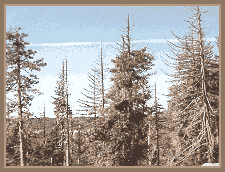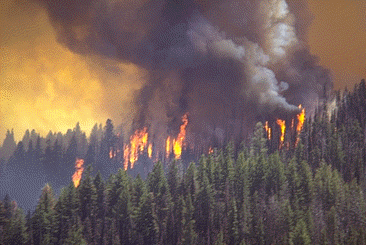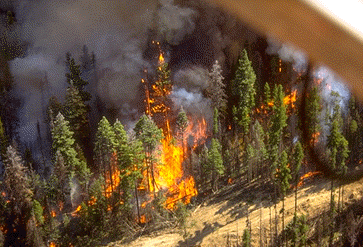Environmental Fairy Tales and Baldface Lies
From the Oregon Daily Emerald, 22. May 1996
By Kelly Andersson
Once upon a time, fairy tales were read by moms and dads to little kids. Once upon a time, environmental fairy tales about families who lost their ranches to the Endangered Species Act were told by anti-environment politicians and then duly relayed by careless reporters.
Now comes a new environmental fairy tale, this time relayed by environmental groups and politicians claiming there is no forest health problem and that all the talk of dead and dying timber is just talk. As the timber salvage issue heads for a vote before a Senate panel this week, the discussion of forest health is heating up in Washington while fires rage in the Southwest.
Senator Bill Bradley, a New Jersey democrat with Oval Office aspirations, is damaging his own credibility and that of the conservation groups with his fairy tale claim that there is no forest health crisis.
"Data collected by the U.S. Forest Service say there is no crisis," he recently said. "All the major environmental groups say there is no crisis." Bradley claims that the problem is a manufactured one, put forth by timber industry lobbyists who favor increased harvests.
Though I won't vouch for the ethics of industry lobbyists I've met, I can assure you that the forest health crisis is not their invention. If you drive Highway 58 east of here or Highway 126 west to the coast, you'd think the only forest health crisis is the landslides caused by record rains and swollen streams. Where are all the dead and dying trees they keep talking about? Do they exist, or is it a fairy tale?

Industry lobbyists ought to put Bradley on a plane and fly him over the Blue Mountains in eastern Oregon. I've flown over most of the Umatilla and Wallowa-Whitman National Forests, and I've worked on wildfires in Oregon and California and Montana.
I've ridden horseback along ridges in eastern Oregon, where you can see for a hundred miles or more, and the sight of miles-long expanses of dead grey trees made the hair on the back of my neck stand up. The long deep canyons wind down from wind-blown ridges, with hawks drifting above thick stands of tightly-packed dead trees -- it sends shivers up your back. Flying over ridge after slope after ridge of dense dead timber stands is enough to make you cry.
Believe me, the forest health crisis is for real.

Just writing about it gives me the chills. But remembering the howling winds and raging walls of fire and billowing columns of smoke I've seen on wildfires, and then reading Bradley's claims that there is no forest health crisis -- well, that infuriates me.
If you haven't seen any dead and dying timber, go take a look. Imagine trees and underbrush so thick that you can't walk through it. Some of it on eastside forests is so thick that you couldn't drive a D4 Cat through it. Oldtimers there refer to it as "doghair" timber -- trees so closely spaced that it looks like hair on a dog's back. Now imagine that it's all tinder-dry, and imagine that we're in another drought summer. Add lightning and you have a prescription for disaster.

I know it's hard to handle the word "drought" with the record rainfall and flooding we've suffered recently. But if you look at the last hundred years or so, you'll find that early heavy rains and flooding allow for a strong green-up and heavy growth of vegetation; the years in which such conditions are followed by a hot dry summer are invariably record years for wildfires.
The dead and dying timber is for real. The fire hazard is real. Widespread damage from insect infestations and forest diseases is real. The need to deal with it is real. But the claim that the forest health crisis is a figment of the industry's imagination is a fairy tale. Claiming that the Forest Service has denied a forest health crisis is just a bald-faced lie. Senator Bradley and the environmental groups should recognize that such propaganda does not help their cause. Despite its flaws, the Forest Service is the best thing we've got going for us in terms of forest management.
Perhaps we'll live to see the day when everyone's happy with the management of our public lands. It's not likely, though -- consider this quote from the President:
"We are coming to recognize as never before . . . the essential matter of natural resources. The time has come for a change. As a people we have the right and the duty . . . to protect ourselves and our children against the wasteful development of our natural resources."
Teddy Roosevelt said that -- 88 years ago last week -- at the Governors' Conference on Conservation in 1908. We've been arguing about this for a long time, and aren't likely to solve it to everyone's satisfaction. But in the meantime, we need to listen to statements such as Bradley's with a critical ear -- and beware of fairy tales.
© 1996 Kelly Andersson
Photos © Paul Ennor and Ric Balfour of the Oregon Department of Forestry.
These two have more great photos online.
![]()